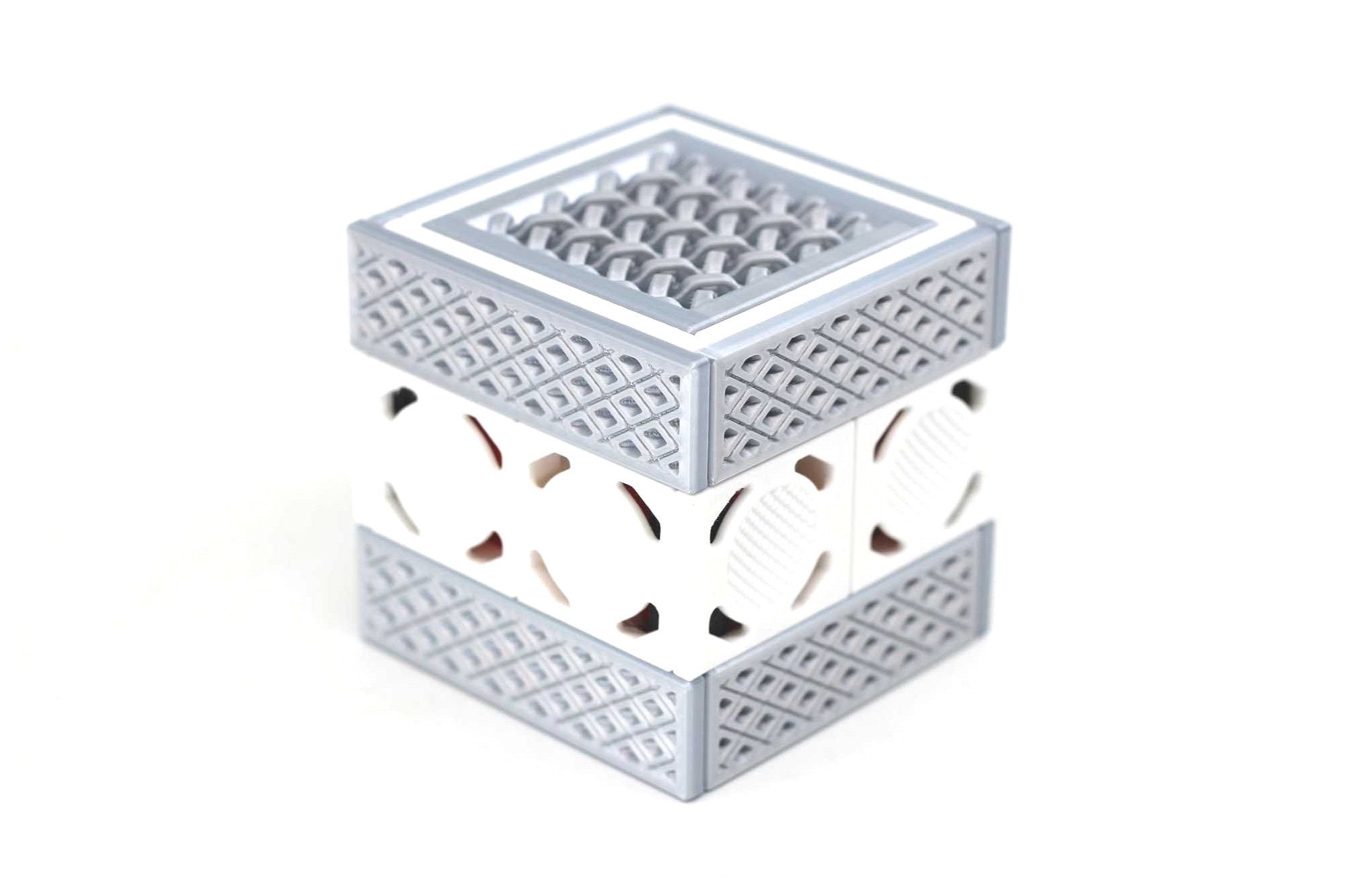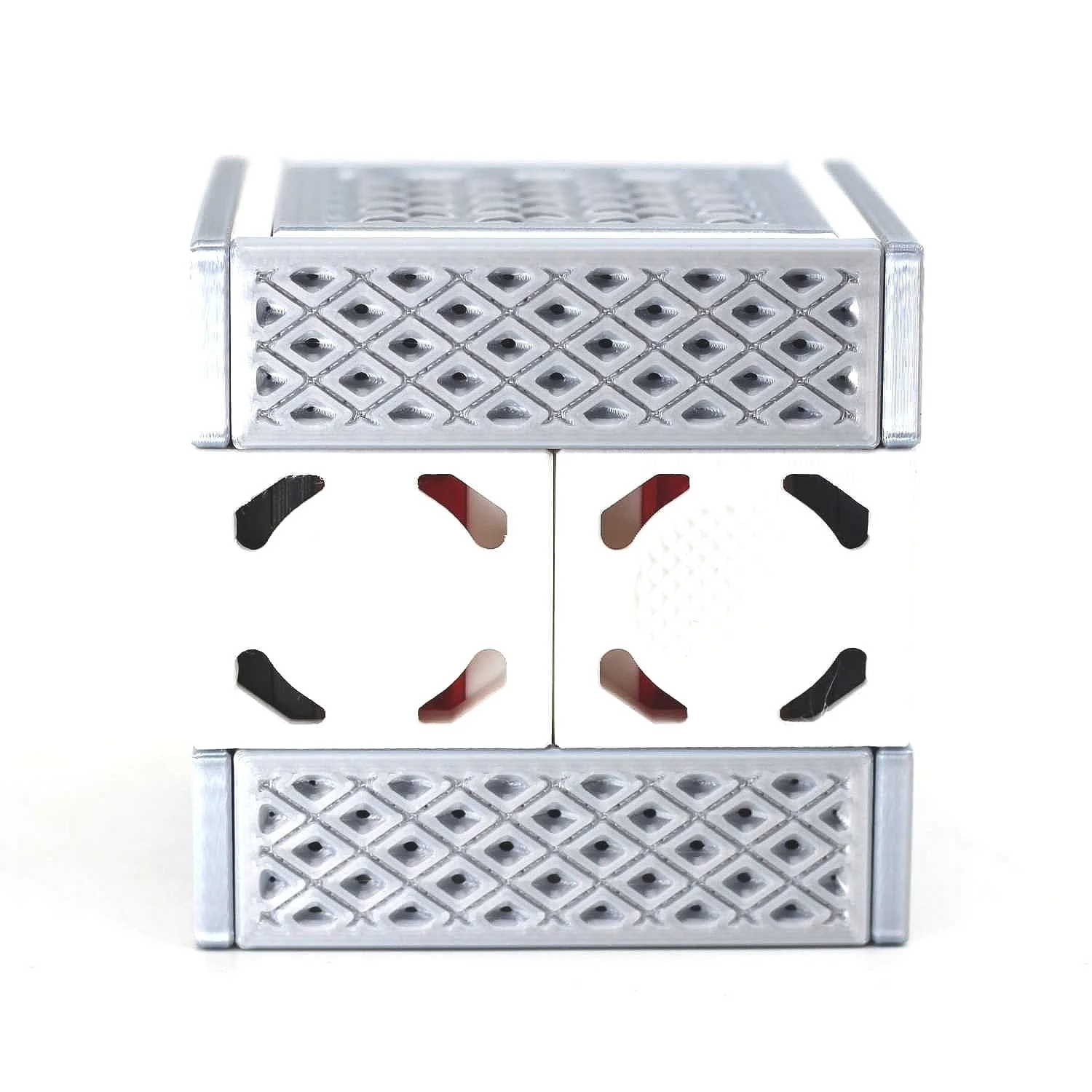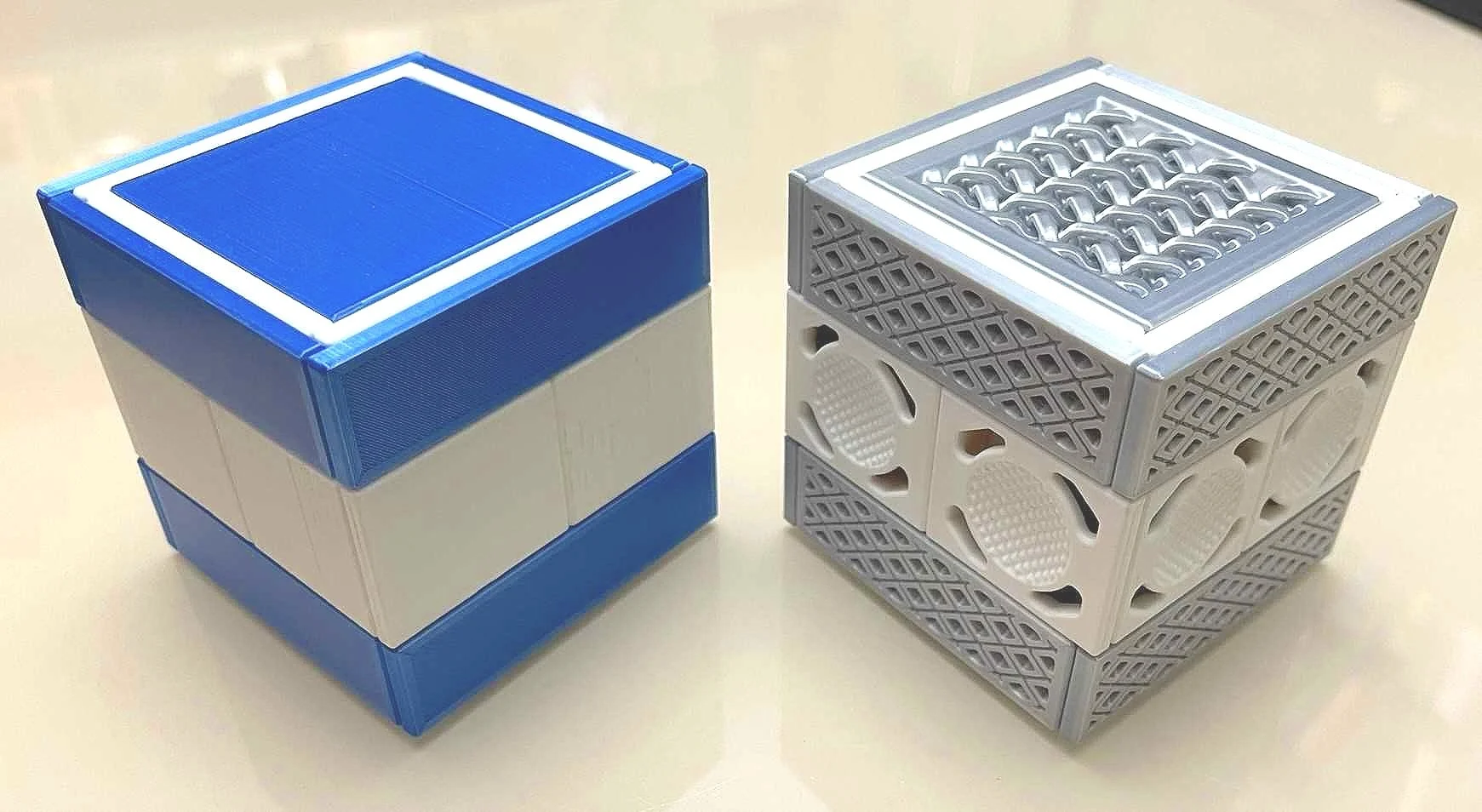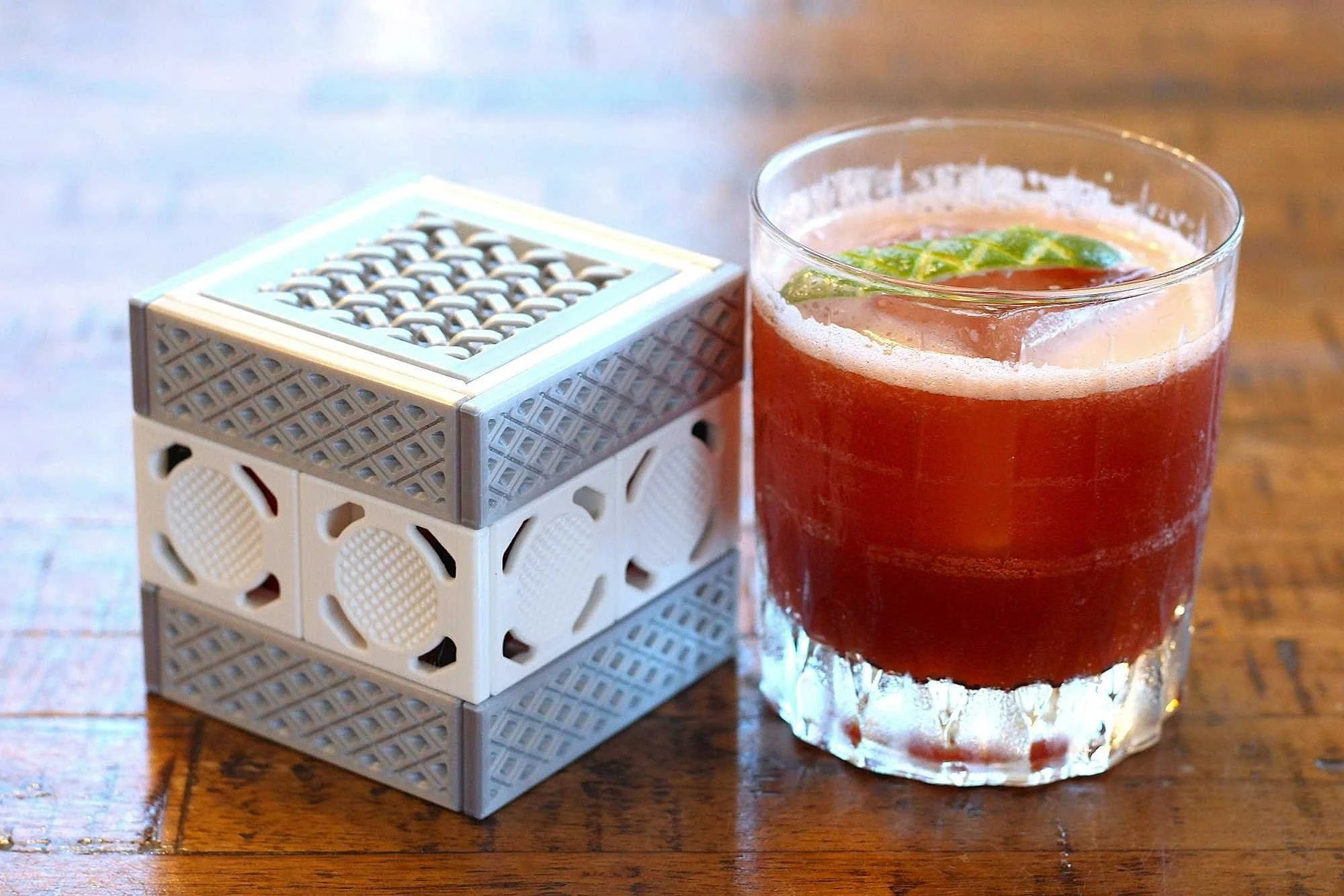Fundamental Lee
Piston Box
Piston Box by Lee Krasnow
Lee Krasnow has been busy. After completing his dream production of the metal and wood hybrid Clutch Box, and during his move from Portland to Michigan, which included his entire workshop (including some seriously heavy machines), he launched not one but two new puzzle creations which debuted at IPP 41 in Houston this past summer. One was the Get in the Spirit cocktail shaker, which I exchanged during IPP, and the other was the Piston Box, which was exchanged by Keith Jackson. Piston, a marvel of 3D printed mechanical engineering, is best described by Lee with this blurb from his website: “it is simultaneously a serial interlocking sequential motion burr puzzle and contemporary take on the best of classic style Japanese puzzle boxes which can be reconfigured with various included color coded maze plates for additional puzzle challenges.” The aesthetically pleasing cube is heavy in the hand, chock full of approximately 87 individual parts, and stores the added maze plates inside, so you’ll need to solve the presentation set before you can move on to further challenges. It’s an idea that Lee has had developing, evolving and perfecting for quite a while. Lee recently told me the story.
getting to the bottom of things
Piston Box is based in part on Lee’s award winning Clutch Box, and anyone who has experienced the former will recognize the reference; Piston also includes ideas he has had for a decade and a half brewing in his mind. The history of the Clutch Box can be read here, and pictures of all the editions are available on his website. He debuted the puzzle in 2003 and took home the coveted IPPDC Puzzler’s Award. Up until 2020, only 9 Clutch Boxes existed. He made Clutch #10 and #11 for a particularly annoying customer, which led to an additional set of 10 puzzles in wood, with stellate lid patterns, and then a final set of 10 in wood with a spiral lid pattern. Finally, he could work on the hybrid wood and metal version he always wanted to make.
will it cause internal combustion?
After he began to revisit the Clutch Box in 2020 he also needed an outlet for new ideas. Somewhere between the rebirth of those two new Clutches he made for me and the remaining 20 in the wood editions, he designed Piston Box. He was feeling in general that is was a huge tedious pain to do more wood Clutches because what he really wanted to do was move on with his machined metal parts version. So in the meantime, to occupy his mind and serve as a creative outlet (“whet his whistle”), he realized he could make a 3D printed design of something new which would not compete for his production time on the wooden Clutches. He describes his foray into designing Piston Box, while still working on the Clutch Boxes, as “me breaking into the liquor cabinet of my design vault and taking a sip”. He mentions as well that perhaps the ultimate motivation for putting the design into reality was due to a breakup - hoping to impress her, and maybe get back. Of the amazing design, she apparently said it would please his customers. So much for impressing her, but she was not wrong. Around that same time he had other bursts of creativity, and also made the Coffin like Ballbuster and Nutbuster dissection puzzles.
weaving many challenges
That first iteration of Piston Box was mostly a chance to show something cool, but he knew it was not ready for prime time and put it on the shelf. He didn’t take photos of it, knowing such might incite his fan base and then he would want to sell it. He knew if needed more time to develop. The first version did not have the removable maze plates, and it felt somehow arrogant to carve the original maze into the panels so permanently, knowing there were many so other possibilities and not wanting to whittle it down to one pattern. He relates that the idea for swappable mazes occurred at some point during a visit to Austin for a local puzzle gathering hosted by Tanner Reyes. He gave Tanner a prototype, which was squat and chunky, quite different from the current version today. Piston Box can be entirely disassembled once fully solved, and the frame falls apart from the inside (just like Lee’s keychain puzzle). So that if something is inside it, it can’t come apart. The idea for replaceable plates was a game changer, and allowed the puzzle to reach a new potential, with new maze options stored inside, while also solving the problem of selecting a unique starting panel assembly design.
courtesy of Tanner Reyes
After 1-2 years of resting the original Piston prototype, Lee redesigned it into a cube shape which could contain the additional maze plates in the inner space. Tweaking the structure to have the maze plates fit inside the box came from ideas started years ago in discussion with Kagen Sound and John Rausch over Kagen’s Maze Burr puzzle, which originally came with additional maze panels in a separate container. Lee made a metal version of the maze burr. It seemed a shame that the extra plates couldn’t somehow be contained within the puzzle itself. Kagen solved this problem in later iterations of the Maze Burr Box and its descendants, and Lee has designed the Piston Box with a similar sensibility.
courtesy of Tanner Reyes
The current iteration of the Piston Box includes design elegance as well. The mazes maximize movements and directional interplay. The cube dimensions now match Lee’s other cubic print, the Barcode Burr. A few elements owe input from Keith Jackson, who would go on to exchange the Piston Box at IPP41. Keith added useful feedback and optimization from a puzzle solving perspective, approaching it from a “sequential discovery” perspective. Keith first saw a prototype of the puzzle in January 2024, and he notes that “the design, especially the exterior, changed a lot from that version to the one I exchanged. I had a lot of interaction with Lee. Still, the final product is something like 97% Lee and 3% me. Maybe the most visible input I had was adding the recesses onto the key plates to make it easier for the puzzler to slide them.”
courtesy of Keith Jackson
Lee mentions he was a bit resistant to some of Keith’s ideas in the beginning but over time accepted them as improvements. An example is how the extra maze plates are neatly contained inside within separate sleeves which keep things organized. Without the sleeves, Lee could fit another whole set of plates, or could add interchangeable plates to existing sets. But opening the box would result in a messy explosion of “pick up sticks”, which was less elegant. Having the nicely organized set bricks inside was much cleaner, cooler, and allowed better visualization of the intricate internals. It even allowed a space for a coin …
courtesy of Keith Jackson
As Keith mentions, the appearance of the puzzle changed dramatically, into what one might expect from someone with Lee Krasnow’s abilities and standards. Lee evolved the design aesthetic by layering 3D textures to keep the appearance modern, relevant and unique. He did not want the puzzle to look dated, and he did not want it to be easily reproduceable. He achieved what he calls a design “trifecta”: having a cool concept which requires clockwork engineering, having intricate design details realized through high quality 3D printing, and using his mathematical acumen to create a “geometric watermark”, which is a very interesting concept in and of itself. In essence, it would be very hard to precisely replicate what he has done without the print files.
sipping from the design cabinet
Piston Box is a beautifully crafted puzzle that feels very high end in the hand and provides significant, complex, multi-step and multi-layered challenges. If you haven’t, sign up for one via Lee’s website contact page. If you ever get the chance, also tip your hat to Keith Jackson, who played a huge role in ensuring the puzzle was introduced to the world. Keith relates, “This was a spendy project. I half-joked early on that everyone would love my Lee Krasnow exchange except for me, due to the cost. But in the end, I was quite happy. I was proud to exchange this gorgeous puzzle by a highly-regarded maker. I was excited to be the one to launch the Piston Box into the wider puzzle world.”
The Space Between
Here’s a toast to this grand adventure, which provides an insider’s tour into the space between how certain puzzling creations are born and produced. It celebrates the time required for some achievements to mature, develop and evolve; acknowledging the space between first concept and final version. It also admires the optimized use of the space between the panels in a puzzle box, a space most often void of any other purpose besides being “opened” (a fine purpose, no question), which in this case contains a multitude of new adventures. How marvelous.
I first experienced this cocktail at Coltivare, a beloved garden to table restaurant in Houston and a local favorite, on their summer menu this year. It was one of those drinks that was so good, you need to request the “specs” from the bartender, so you can recreate it for yourself at home again. Which is always a dubious endeavor, either because the staff think there is no way you could possibly know how to do that, or because the bartenders are a bit protective of their recipes. More often, luckily, folks in the industry are generous of spirit, so to speak, and happy to share. I was eventually handed a scrap of old cardboard coaster with the secrets scribbled down. The drink is a sweet and smoky summery mezcal margarita that hits just right. Here’s to the makers – cheers!
make space for this pair
The Space Between
1 ½ oz mezcal
1 ½ oz honey pineapple syrup (2:1)
½ oz lime juice
4 dashes tiki bitters (I subbed Ango plus allspice)
2 dashes spicy tincture
Shake ingredients with ice and strain into a favorite glass. Dehydrated orange garnish.
explore more:











